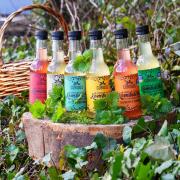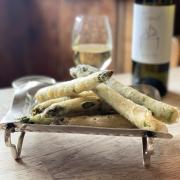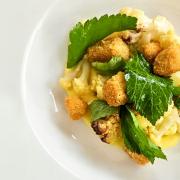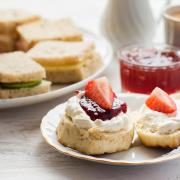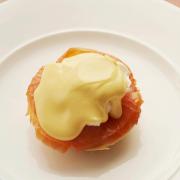Wondering what to knock up for supper tonight?
Award-winning Dorset-based food writer Sue Quinn shares recipes from her latest book, which is all about transforming leftovers in fridge, cupboard and veg draw into delicious dishes.
How can one single lonely floret of broccoli be the inspiration for a cookbook? Let me introduce you to my mum. When I was a kid, our fridge was always brimming with oddments because she threw absolutely nothing away. Scrapings of cream clinging to the sides of a carton, milk that had turned a bit sour, chicken bones, tiny morsels that hadn’t been eaten from a previous meal, cold porridge … they were all kept and used up. I even remember a single floret of cooked broccoli camping out in the fridge, waiting for a home in a new meal.
Although I found this approach a bit odd when I was a child, my mum’s respect for the value of food, and her resourcefulness, rubbed off. Later, when I was flat sharing, my housemates and I would play our own version of the television series Ready Steady Cook coming up with crazy meals made from the slim pickings – and leftovers – lurking in the fridge. Now, I find the most interesting and satisfying way to cook is to base meals around remnants of other meals, as well as surplus food, and bits and pieces that are past their best.

Why? First of all, leftovers often taste better than the first iteration of a dish, because the flavours have had time to mingle and develop. That’s why so many of us find Boxing Day leftovers just that little bit tastier than the original Christmas Day meal.
Secondly, it’s exciting to corral ingredients that need using up on the benchtop and come up with interesting, delicious and sometimes unlikely ways to bring them together in a meal. (Let me tell you a secret: I’ve now written 15 cookbooks and some of the best recipes I’ve developed are the result of using what I had, rather than what I thought I needed, in a dish).
As well as being financially foolish, wasting food harms our planet because it accelerates climate change. Food dumped in the bin will go on to sit in a landfill and produce vast amounts of methane while it slowly decomposes
But while it’s financially and environmentally sensible to cook with leftovers, I prefer to view them as potentially delicious future meals rather than using them up as being a worthy act. We all love classic leftover dishes, like bubble and squeak and hash with an egg on top. But leftovers offer much more; they deserve to be celebrated in delicious ways. I hope the recipes in my book Second Helpings will inspire you to love leftovers more. And what should you do with a single cooked broccoli floret? You’ll have to read the book to find out. In the meantime, here are some recipes from the book to inspire you and hopefully get you rooting through your fridge.
All recipes taken from Second Helpings: Delicious dishes to transform your leftovers by Sue Quinn published by Quadrille at £18.99

Roast Dinner Enchiladas
Often, there’s not enough left of any one ingredient after a roast dinner to pull together a whole new meal – you’ve just got scraps of meat and vegetables. These enchiladas are the perfect carrier for whatever’s left – gently spicy, filling and comforting. Use whatever jumble of cheeses you have in the fridge, too.
Leftovers: cooked vegetables, cooked meat, cooked sausages, odds and ends of cheese
Serves 4–6
Preparation: 40 minutes
Cooking: 25 minutes
500–600g leftover cooked meat and/or vegetables, chopped
200g grated hard cheese (Cheddar, Parmesan, Gruyère, Lancashire or a mix)
4 large tortilla wraps
For the tomato sauce
2 tbsp olive oil, plus extra for brushing
1 large onion, finely chopped
2 garlic cloves, finely chopped
2 tbsp chilli powder
2 tbsp smoked paprika
1 tbsp ground cumin
1 tsp dried oregano
2 tsp brown sugar
1 tsp fine sea salt
2 x 400g cans chopped tomatoes
Method
For the sauce, warm the oil in a large frying pan and fry the onion until soft and golden, about 8 minutes. Add the garlic and cook for 1 minute. Add the spices, oregano, sugar and salt and cook gently, stirring, for a further minute. Add the tomatoes and simmer gently for 15 minutes, stirring now and again, until you have a rich, thick, deep-red sauce. Taste, add more salt if needed, then take the pan off the heat.
Meanwhile, preheat the oven to 180°C/160°C fan/350°F/gas mark 4 and brush a baking dish measuring about 20cm square with olive oil.
Distribute the leftovers and half the cheese equally between the wraps and roll them up. Arrange them in the prepared baking dish – they should fit snugly. Spoon the tomato sauce between and over the wraps. Sprinkle the remaining cheese on top. Bake for 20–25 minutes until golden and bubbling. Serve hot with salad on the side.

Tender Baked Halloumi with Chimichurri
If you’re a bit unsure about halloumi due to its rubbery, squeaky character, try cooking it this way. It’s amazing. Frying it first creates a golden outer crust, then roasting it whole delivers a juicy and fudge-soft inner texture. Paired with chimichurri, a punchy Latin American sauce, this dish takes care of any half-used packs or bunches of soft herbs – both leaves and fine stalks – and is perfect as a light lunch. Thanks to Dorset-based chef Jesse Wells at Terroir Tapas in Southbourne for the inspiration and halloumi chat.
Leftovers: fresh herbs, chillies
Serves 4
Preparation: 15 minutes plus 10 minutes soaking
Cooking: 18 minutes
2 blocks of halloumi
130ml olive oil, more or less as needed
handful of fresh herbs and tender stalks: parsley, coriander, dill, mint, chervil, basil
1 medium red chilli, deseeded and roughly chopped
1 large garlic clove, roughly chopped
1⁄4 tsp dried oregano or mixed herbs
1 tbsp red wine vinegar or sherry vinegar, or more to taste
1 tbsp lemon or lime juice, plus extra
Method
Preheat the oven to 200°C/180°C fan/400°F/Gas mark 6. Place the halloumi blocks in a bowl of cold water and soak for 10 minutes to tenderize and reduce saltiness. Pat dry with a paper towel.
Set an ovenproof frying pan, ideally non-stick, over a medium-high heat. When hot, add 2 tablespoons of oil and fry the halloumi blocks on one of their large sides until golden. Fry all the small sides until golden, leaving one large side uncooked.
With the uncooked sides pan-side down, transfer the halloumi to the oven and bake for 18 minutes, until very soft. Start checking after 15 minutes.
Meanwhile, make the chimichurri. Very finely chop the fresh herbs and place in a bowl with the chilli, garlic and oregano. Add the vinegar, then gradually stir in the remaining oil to make a very loose sauce – you might not need all the oil. Add the lemon juice and taste; stir in more lemon juice, salt or oil if needed.
Serve the halloumi hot (don’t hang about, as it firms up quickly as it cools) with the chimichurri spooned over.
Also try ...
Serving chimichurri on eggs, fish, steak, chicken – or stir through soup and stews to ramp up the flavour. It tastes best when it’s made fresh for the dish.

Whipped Flavoured Butters
As I write this, flavoured butter – also known as compound butter – is having a moment. Social media is gleaming with smooth quenelles of butter imbued with everything from miso paste or curry powder to herbs or Bloody Mary. It’s easy to understand why; butter is a flavour carrier, so a scoop or disc served on top of meat, fish or vegetables can seriously ramp up the flavour of an otherwise plain dish.
For those who love finding nifty uses for leftovers, flavoured butters are a blessing. A spoonful of curry paste left in the jar, a bunch of herbs you won’t use up before they wither, a tablespoon or two of capers, the remnants of a jar of honey that has crystallized... almost anything can be whipped into flavoured butter. These are quick and easy to make – it’s just combining softened butter and something delicious into a tasty union. The added bonus is that they can be chilled or frozen to use later. I’ve suggested four flavoured butters here that make great use of leftovers, but the possibilities really are endless.
For each, whip 100g of unsalted butter until soft and creamy – use electric beaters for extra airiness – or mash with a fork. Then, beat in the ingredients listed. Spoon the butter onto a rectangle of baking paper and roll into a cylinder, twisting the ends like a cracker. Chill, or if you want to freeze the butter, slice the cylinder into discs before wrapping. Then, just snap off one or two as needed.
Leftovers: capers, fresh herbs, harissa paste, honey
Lemon caper butter
Place a disc on top of cooked chicken or seafood, or melt the butter and spoon over.
1 tbsp finely chopped capers, rinsed if packed in salt
1 garlic clove, grated
1 tbsp finely grated lemon zest
1 heaped tbsp finely chopped parsley
1⁄2 tsp sea salt flakes
Garlic herb butter
A great all-rounder. Use for making garlic bread or serve with veg, meat, poultry or seafood.
2 tbsp finely chopped herbs
1⁄4 tsp freshly ground black peppercorns
1 garlic clove, grated
1⁄2 tsp sea salt flakes
Harissa and lime butter
Great with pork, lamb or beef.
11⁄2 tbsp harissa paste
finely grated zest of 1 lime
1⁄2 tsp sea salt flakes
Vanilla bean and honey butter
Slather on toast, muffins, crumpets or pancakes.
2 tbsp honey
1⁄2 tbsp icing sugar
1⁄2 tsp vanilla paste
pinch of fine sea salt

Cherry and Vanilla Rice Tart
Cold cooked rice transformed! This is deeply delicious and reminiscent of a Bakewell tart. I love the contrast of the tangy dried cherries against the sweet vanilla-scented rice, although feel free to use up what you have in terms of dried fruit and jam. Be sure to make the rice filling just before the tart goes into the oven. If you make it first and let it sit for a while, the filling stiffens and the tart won’t be as moist and tender as it should be.
Leftovers: cooked rice
Serves 6–8
Makes 1 x 20cm (8in) tart
Preparation time: 10 minutes plus 30 minutes chilling
Cooking time: 55 minutes
1 sheet ready-rolled shortcrust pastry
3 tbsp cherry jam
1 large egg, lightly beaten
250g cold cooked long-grain white rice
40g caster sugar
3 tbsp milk, or more if needed
1 tsp baking powder
pinch of salt
2 tsp vanilla extract or paste
30g dried cherries, roughly chopped
40g flaked almonds
Method
Preheat the oven to 180°C/160°C fan/350°F/gas mark 4 and slide a baking sheet inside.
Line a 20cm tart tin with the pastry, prick holes in the base with a fork and chill for 30 minutes. Line with baking paper and fill with baking beans (or use dried beans or rice). Transfer to the hot baking sheet and bake for 15 minutes. Remove the baking paper and beans and bake for a further 10–15 minutes, until pale gold. Remove from the oven and put the baking tray back in to stay hot.
Give the jam a good stir to loosen and spread over the base of the pastry case.
Now make the filling. Put all the remaining ingredients except the cherries and almonds in the bowl of a food processor and whizz together. You want the mixture as smooth as possible and to drop easily off a spoon; add more milk if necessary. Stir in the dried cherries and immediately spoon the batter into the pastry case. Sprinkle over the almonds and bake for 20–25 minutes or until the filling is just set. Serve warm with cold crème fraîche or softly whipped cream.
Why not also try ...
Making pancakes with the filling batter instead of a tart filling but leave out the dried fruit and nuts. Add heaped dessert spoonfuls to a hot frying pan greased with butter. Cook for 1–2 minutes on each side until golden – they burn easily so don’t have the heat too high. Serve with your favourite pancake toppings – fresh berries with yoghurt are lovely.

Meet Sue Quinn
Sue is an award-winning food writer, cookbook author and journalist who lives with her family in Bournemouth. Her articles and recipes regularly appear in the UK’s leading food publications including the Telegraph, Sunday Times, Guardian, Delicious, Waitrose magazine and BBC Food. She has won the Fortnum & Mason’s Online Food Writer Award and the Guild of Food Writer’s award for her work on British food, and been shortlisted for the Guild of Food Writer’s 2023 Food Writer’s Award.
Born in Australia, Sue began her career as a news reporter, working for News Ltd International in Sydney and Canberra, before moving the UK as London correspondent. After a stint at the Guardian, she went freelance, and began editing and then writing cookbooks ranging from children’s cookery and a book on cocoa to Japanese and vegan cookery.
Find out more at penandspoon.com follow on X and Insta @penandspoon








